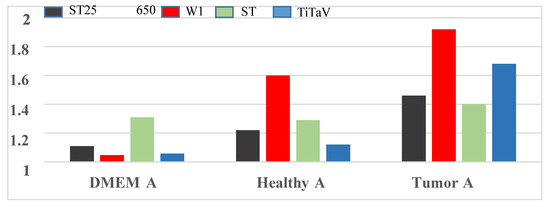1. Introduction
One of the greatest goals in medicine is early-stage detection of tumors, to allow physicians and surgeons to apply the available therapies, which are usually successful on small volume cancers only. Our purpose is to identify the presence of a cancer by detecting the volatile organic compounds (VOC’s) exhaled by cancer cells that are different by the ones exhaled by healthy cells, through a chemoresistive sensor array. In this study, a fast-responding, reliable and reproducible sensing technique proved to discriminate cancer cells from the healthy ones, making it a good cancer screener with a very low invasiveness. The measures have been performed on cancer and healthy tissues coming from human colon and rectum, with the aim of extending the study to the other type of tumors. Neoplastic tissues exhibit altered metabolic processes with respect to the metabolism of healthy cells, therefore the chemicals (metabolites) expelled during cellular respiration depend upon the cell health status. In this study, a device named SCENT B1 [1] is used with the aim to discriminate between normal and malignant tissues, by using an array containing four nanostructured chemoresistive metal-oxide sensors (nanograins with average size of 40–50 nm) manufactured in the Sensor Laboratory of the University of Ferrara.
Concurrently to the tissues investigation, samples containing different kind of immortalized cells have been investigated using the same sensor array, with the target of discriminating the different immortalized cell types and of analyzing the sensor responses depending on the cell concentration (after 24, 48, 72 h of incubation).
2. Experimental Section
The voltage output of each sensor is directly proportional to its conductance and, in turn, it depends upon the chemicals interacting with its surface [2,3]. Figure 1 shows the ratio ΔG/G, where ΔG is the difference between the sensor conductance with and without the metabolites expelled by the cells of a tissue.

Figure 1.
Histogram of the responses of four different sensors to the cell samples exhalations.
All four sensors gave larger responses (although with different amplitudes) to tumor tissue with respect to the healthy one. Smaller responses were given by the DMEM only (Figure 1).
These results are consistent with the stronger metabolism of tumor cells with respect to the healthy ones, because the former emits larger amounts of VOCs [4,5].
In Figure 2 a histogram of the responses of four different sensors to cell sample exhalations with different initial plating concentrations 250k, 500k and 1 M. It is evident that the device is capable of distinguishing different cell samples at different concentrations.

Figure 2.
3D Histogram of the responses of four different sensors to cell sample exhalations with different initial plating concentrations 250k, 500k and 1 M.
Acknowledgments
This research was funded by the research grant of National Science Centre, Poland grant decision DEC-2016/20/S/ST5/00165 and partially realized within the Statutory Funding of Institute of Electronics, Silesian University of Technology, Gliwice, BK as well as BKM.
Conflicts of Interest
The authors declare no conflict of interest.
References
- SCENT B1, Italian. Combinazione di materiali semiconduttori nanoparticolati per uso nel distinguere cellule normali da cellule tumorali. 102015000057717, 10 February 2015.
- Zonta, G.; Anania, G.; Fabbri, B.; Gaiardo, A.; Gherardi, S.; Giberti, A.; Guidi, V.; Landini, N.; Malagù, C. Detection of colorectal cancer biomarkers in the presence of interfering gases. Sens. Actuators B Chem. 2015, 218, 289–295. [Google Scholar] [CrossRef]
- Zonta, G.; Anania, G.; Fabbri, B.; Gaiardo, A.; Gherardi, S.; Giberti, A.; Landini, N.; Malagù, C.; Scagliarini, L.; Guidi, V. Preventive screening of colorectal cancer with a device based on chemoresistive sensors. Sens. Actuators B Chem. 2017, 238, 1098–1101. [Google Scholar] [CrossRef]
- Chan, E.C.Y.; Koh, P.K.; Mal, M.; Cheah, P.Y.; Eu, K.W.; Backshall, A.; Cavill, R.; Nicholson, J.K.; Keun, H.C. Metabolic Profiling of Human Colorectal Cancer Using High-Resolution Magic Angle Spinning Nuclear Magnetic Resonance (HR-MAS NMR) Spectroscopy and Gas Chromatography Mass Spectrometry (GC/MS). J. Proteome Res. 2009, 8, 352–361. [Google Scholar] [CrossRef] [PubMed]
- Altomare, D.F.; di Lena, M.; Porcelli, F.; Trizio, L.; Travaglio, E.; Tutino, M.; Dragonieri, S.; Memeo, V.; de Gennaro, G. Exhaled volatile organic compounds identify patients with colorectal cancer. Br. J. Surg. 2013, 100, 144–150. [Google Scholar] [CrossRef] [PubMed]
© 2019 by the authors. Licensee MDPI, Basel, Switzerland. This article is an open access article distributed under the terms and conditions of the Creative Commons Attribution (CC BY) license (https://creativecommons.org/licenses/by/4.0/).